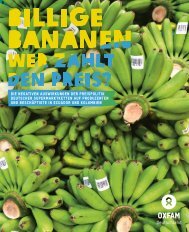228776e
228776e
228776e
Create successful ePaper yourself
Turn your PDF publications into a flip-book with our unique Google optimized e-Paper software.
SPAIN<br />
The sample<br />
The sample consists of one history textbook (T2) and four history and social studies textbooks<br />
published between 2008 and 2011 and designed for use by pupils aged sixteen studying in<br />
state and private schools. All textbooks deal with the Holocaust over between three and six<br />
pages in sections devoted to the Second World War, with the exception of T2, which places<br />
the Holocaust in a section entitled ‘Fascism and Nazism’. T1 contains a subsection devoted<br />
to ‘Genocides, Deportations and Other Consequences of War’, and T4 contains a subsection<br />
called ‘The Concentration Camps’.<br />
Scale<br />
The textbooks generally do not date the Holocaust clearly. Neither does T1, for example,<br />
provide information about dates or places in captions to photographs. T2 and T3 frame the<br />
event between 1933 and 1942, while T2 also mentions the November pogrom of 1938. The<br />
textbooks generally locate the event in Germany and Europe, while links to other locations are<br />
made as follows: to fascism in Italy (T5), to the bombed cities of London and Berlin (T3) and to<br />
Europe generally in maps of events of the war (T4) and of camps in Europe (T5). T2 links the<br />
Holocaust to Spain by printing and explaining a photograph of Spanish Republicans who were<br />
imprisoned in Mauthausen, to Europe on the basis of a map of the locations of concentration<br />
camps, and to the world generally by featuring a map depicting the sites of other genocides.<br />
Protagonists<br />
All of the textbooks focus on Jewish victims, while T1 also lists ‘Slavs and other ethnic and<br />
religious groups, Gypsies, Jehovah’s witnesses, homosexuals, trade unionists and persons<br />
with congenital diseases’. T5 mentions ‘communists and democrats’, T3 ‘political opponents’<br />
and ‘delinquents’, and T2 ‘Latinos’. None of the textbooks deal with Jewish history before<br />
1933 or after 1945, except indirectly via a reference to the numbers of refugees fleeing Europe<br />
from 1932 in T2. T2 also prominently features exiled Spanish Republicans imprisoned in<br />
Mauthausen. Hitler features in all textbooks, and T2, T4 and T5 place particular emphasis<br />
on the personal influence of Hitler and his ideas on the event, if not as a central cause of the<br />
event. The additional mentions of Himmler in T1, of Mussolini in T4 and the Nuremberg Trials<br />
in T3 largely ascribe responsibility for the event to the Nazi elite. German bystanders are<br />
mentioned in T2, while German resistance features in T1 and T5, as does the collaboration<br />
of people in territories occupied by Germany in T5. Images represent approximately equal<br />
numbers of victims and perpetrators, while T2 and T5 feature Hitler, the latter combining<br />
Hitler’s biography with Nazi ideology derived from Mein Kampf.<br />
142




